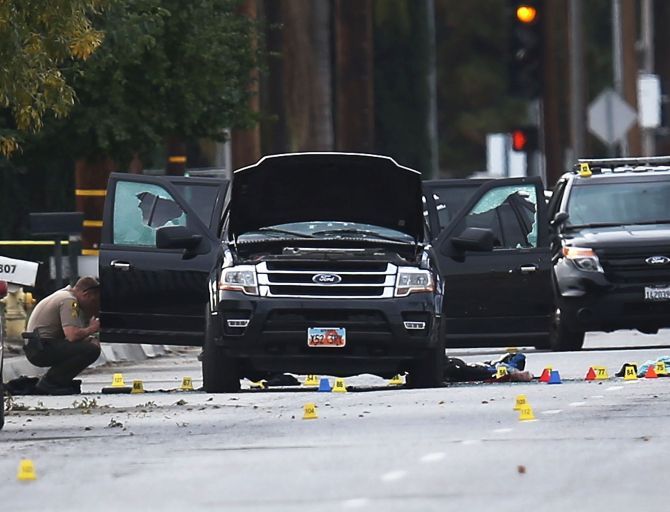
The Pakistani-origin gunman who carried out the massacre of 14 people in California along with his Pakistani wife may have been radicalised as he was in touch with extremists, officials said on Friday, as an arms haul from their home indicated they were planning another attack.
Police said that while searching the apartment of the couple -- Syed Rizwan Farook, 28, and his wife Tashfeen Malik, 27, -- they found an armoury of weapons and explosives, including a dozen pipe bombs and thousands of rounds of ammunition.
The Federal Bureau of Investigation has taken charge of the probe into Wednesday’s mass shooting in San Bernardino, California, and were combing through evidence, including cell phones and a computer hard drive to determine what prompted Farook and Malik to carry out the attack that claimed 14 lives and left 21 people wounded.
The FBI is treating the shooting as a potential terrorist act, though the agency is far from concluding that it was, two law enforcement officials said.
Farook, who is Pakistani-origin, and Malik, who is a Pakistani national, fired as many as 150 bullets inside the Inland Regional Center and then in the shootout with the police that left the couple dead, officials said.
The authorities have also released the names of the 14 victims, ranging in age from 26 to 60.
With the FBI examining Farook’s electronic devices, analysts and agents have found evidence that at least a day before the attacks, he began deleting data leading investigators to believe that he was planning the attack.
“It’s not like he got angry and came back and started deleting and destroying things,” an official was quoted as saying by the New York Times.
Farook and Malik were found in black tactical gear, sans ballistic vests, police said. The attackers had legally purchased their two handguns.
The assault-style rifles were purchased by someone who is now under investigation, said San Bernardino City Police Chief Jarrod Burguan.
“Certainly they were equipped and they could have continued to do another attack...We intercepted them,” Burguan told reporters.
“If you look at the amount of obvious pre-planning that went in, the amount of armaments (they) had, the weapons and the ammunition, there was obviously a mission here. We know that. We do not know why,” said David Bowdich, assistant director in-charge of the FBI’s Los Angeles office.
“We don’t know if this was the intended target or if there was something that triggered him to do this immediately. We just don’t know,” he said.
Farook was in contact with a small number of suspected extremists, officials were quoted as saying. Not only this, he had apparently communicated with at least one person who is currently being monitored as a potential terror suspect.
The communications were “soft connections” in that they were not frequent, an official said.
It had been a few months since Farook’s last back-and-forth with these people.
Farook, whose parents migrated from Pakistan, according to Bowdich, had recently travelled to Pakistan.
However, neither Farook nor Malik were known to the FBI or on a list of potentially radicalised people, he said.
Malik got an American fiance visa in Islamabad after which she travelled to the US and got married, the US State Department has said.
“She (Tashfeen Malik) got the visa in Pakistan. I’m sure she got the visa in Pakistan,” State Department Deputy Spokesman Mark Toner told reporters.
“She was issued the K-1 visa -- which is normally given to a fiancée -- by the US Embassy in Islamabad. Once a K-1 visa is issued, as per general procedure, the person has to marry the fiancee within 90 days of the arrival in the US,” Toner said.
K-1 visa becomes null and void if the marriage is not done within the stipulated 90 days. Farook’s brother-in-law, Farhan Khan, said the couple got married two years ago.
Meanwhile, Congressman Adam Schiff, Ranking Member of the House Permanent Select Committee on Intelligence, who was briefed on the attack said the FBI is conducting a thorough investigation into the suspects to determine the motive for this attack and whether there is any connection to a terrorist organisation or evidence of domestic radicalisation.
“At this point it is too early to rule anything in or out -- it may have been workplace violence or it may have been more. I am confident the FBI will get to the bottom of what took place and why, and whether anything might have been done to prevent the attack,” he said.
Image: Law enforcement officials investigate around the Ford SUV vehicle that was the scene where suspects of the shooting at the Inland Regional Center were killed on December 3, in San Bernardino, California. Photograph: Joe Raedle/Getty Images











 © 2025
© 2025